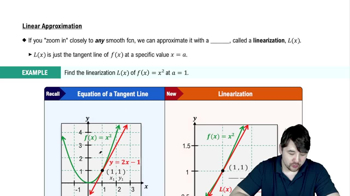Table of contents
- 0. Functions7h 52m
- Introduction to Functions16m
- Piecewise Functions10m
- Properties of Functions9m
- Common Functions1h 8m
- Transformations5m
- Combining Functions27m
- Exponent rules32m
- Exponential Functions28m
- Logarithmic Functions24m
- Properties of Logarithms34m
- Exponential & Logarithmic Equations35m
- Introduction to Trigonometric Functions38m
- Graphs of Trigonometric Functions44m
- Trigonometric Identities47m
- Inverse Trigonometric Functions48m
- 1. Limits and Continuity2h 2m
- 2. Intro to Derivatives1h 33m
- 3. Techniques of Differentiation3h 18m
- 4. Applications of Derivatives2h 38m
- 5. Graphical Applications of Derivatives6h 2m
- 6. Derivatives of Inverse, Exponential, & Logarithmic Functions2h 37m
- 7. Antiderivatives & Indefinite Integrals1h 26m
- 8. Definite Integrals4h 44m
- 9. Graphical Applications of Integrals2h 27m
- 10. Physics Applications of Integrals 2h 22m
4. Applications of Derivatives
Linearization
Problem 4.6.11
Textbook Question
Suppose f is differentiable on (-∞,∞) and f(5.01) - f(5) = 0.25.Use linear approximation to estimate the value of f'(5).
 Verified step by step guidance
Verified step by step guidance1
First, recall the formula for linear approximation: f(x) ≈ f(a) + f'(a)(x - a). This formula is used to approximate the value of a function near a point a using the function's derivative at that point.
In this problem, we are given f(5.01) - f(5) = 0.25. This represents the change in the function value as x changes from 5 to 5.01.
Using the linear approximation formula, the change in the function value can be expressed as f(5.01) - f(5) ≈ f'(5)(5.01 - 5).
Substitute the given change in function value into the equation: 0.25 ≈ f'(5)(0.01).
Solve for f'(5) by dividing both sides of the equation by 0.01: f'(5) ≈ 0.25 / 0.01.
 Verified video answer for a similar problem:
Verified video answer for a similar problem:This video solution was recommended by our tutors as helpful for the problem above
Video duration:
4mPlay a video:
Was this helpful?
Key Concepts
Here are the essential concepts you must grasp in order to answer the question correctly.
Differentiability
A function is said to be differentiable at a point if it has a defined derivative at that point. This means that the function is smooth and continuous around that point, allowing for the calculation of the slope of the tangent line. Differentiability implies continuity, but not vice versa.
Recommended video:

Finding Differentials
Linear Approximation
Linear approximation is a method used to estimate the value of a function near a given point using the tangent line at that point. The formula for linear approximation is f(x) ≈ f(a) + f'(a)(x - a), where 'a' is the point of tangency. This technique is particularly useful for estimating function values when the exact calculation is complex.
Recommended video:

Linearization
Derivative Interpretation
The derivative of a function at a point represents the instantaneous rate of change of the function with respect to its variable at that point. In practical terms, it can be interpreted as the slope of the tangent line to the function's graph at that point. Understanding this concept is crucial for applying linear approximation effectively.
Recommended video:

Derivatives
Related Videos
Related Practice



